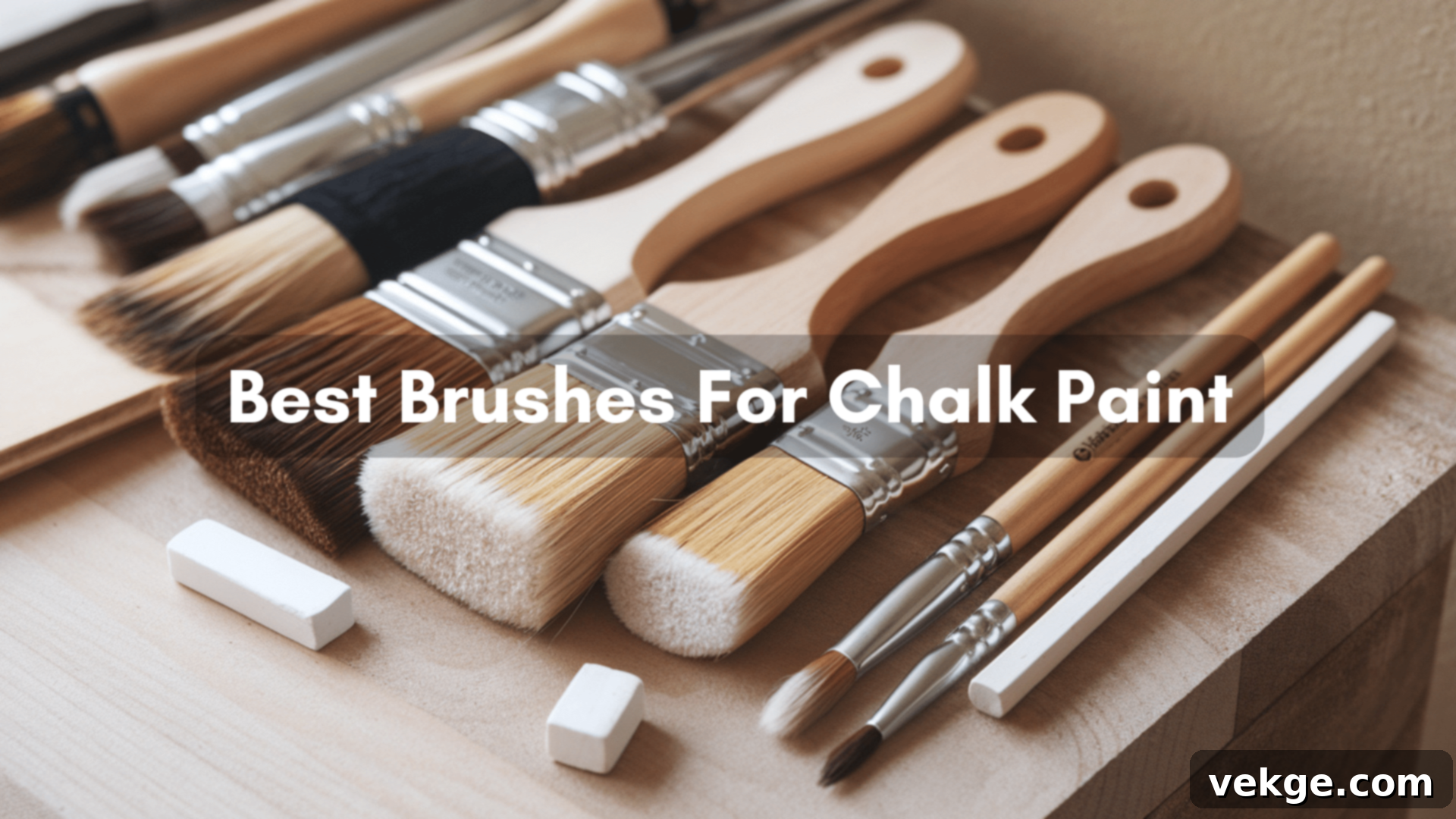Mastering Chalk Paint: The Ultimate Guide to Choosing the Best Brushes for Flawless Finishes
Chalk paint has revolutionized the world of DIY, offering an effortless way to transform old furniture and create stunning vintage, shabby-chic, or modern matte finishes. Its unique, velvety texture and quick-drying properties make it a favorite among enthusiasts. However, to truly unlock the potential of chalk paint and achieve professional-looking results, selecting the right brush is paramount. This comprehensive guide will walk you through everything you need to know about choosing and using the best brushes for your chalk paint projects.
Many beginners often make the mistake of using any old paintbrush they have on hand, only to be met with frustrating streaks, uneven coverage, and a less-than-perfect finish. Unlike traditional latex or oil-based paints, chalk paint has a distinct consistency that demands specific brush characteristics to ensure smooth application and the desired aesthetic. Whether you’re planning to breathe new life into an antique dresser, refresh kitchen cabinets, or embark on a smaller craft project, the brush you choose will significantly impact your painting journey and the final outcome.
In this guide, we’ll delve into the essential differences between natural and synthetic bristle brushes, explore various brush shapes designed for different tasks, and highlight top-performing brushes that deliver exceptional results with chalk paint. By the end, you’ll not only understand why certain brushes outperform others but also gain the confidence to select the perfect tool for every one of your chalk painting endeavors.
Why Do You Need Special Brushes for Chalk Paint?
You might be asking yourself, “Can’t I just use any standard paintbrush for my chalk paint?” While it’s technically possible, the results will often fall short of the high-quality finish chalk paint is known for. There are compelling reasons and significant advantages to investing in brushes specifically designed or highly suitable for chalk paint applications.
Chalk paint possesses a thick, creamy, and often porous consistency. This unique texture requires a brush that can effectively load, distribute, and release the paint evenly across a surface without causing excessive drag or leaving prominent brush marks. Standard paintbrushes, typically designed for thinner latex or oil-based paints, often lack the specific bristle density, firmness, or material composition needed to handle chalk paint optimally. Using them can lead to:
- Streaks and Uneven Coverage: Regular brushes may struggle to spread the thick paint smoothly, resulting in noticeable streaks and patchy areas that require more coats to rectify.
- Poor Paint Retention: Some synthetic bristles, common in regular brushes, might not hold the chalk paint as effectively, leading to more frequent reloading and slower progress.
- Frayed or Damaged Bristles: The friction from applying thick chalk paint can prematurely wear down softer, less resilient bristles found in general-purpose brushes.
In contrast, specialized chalk paint brushes are engineered with features that complement the paint’s properties. They often feature firmer, more densely packed bristles (whether natural or high-quality synthetic) that:
- Distribute Paint Evenly: The bristles are designed to hold a good amount of paint and release it consistently, ensuring smooth and uniform coverage.
- Minimize Brush Strokes: Their structure helps to lay down the paint smoothly, reducing the appearance of brush marks, which is crucial for chalk paint’s signature matte finish.
- Enhance Control: Firmer bristles offer better control over paint flow and placement, allowing for precision in both large areas and detailed work.
- Promote Desired Texture: Natural bristle brushes, in particular, can help achieve the slightly textured, artisanal look that is often sought after with chalk paint, especially for distressed finishes.
Ultimately, using the right brush is a foundational step toward achieving the clean, professional, and beautifully finished results that make chalk paint such a beloved medium for furniture and home décor transformations.
Easy and Effective Brushes for Chalk Painting: Our Top Picks
With a myriad of brushes on the market, finding the perfect one for your chalk paint project can be overwhelming. We’ve narrowed down the field to some of the most highly-regarded brushes known for their exceptional performance with chalk paint. Here’s a detailed look at our top recommendations:
1. Annie Sloan Flat Brush
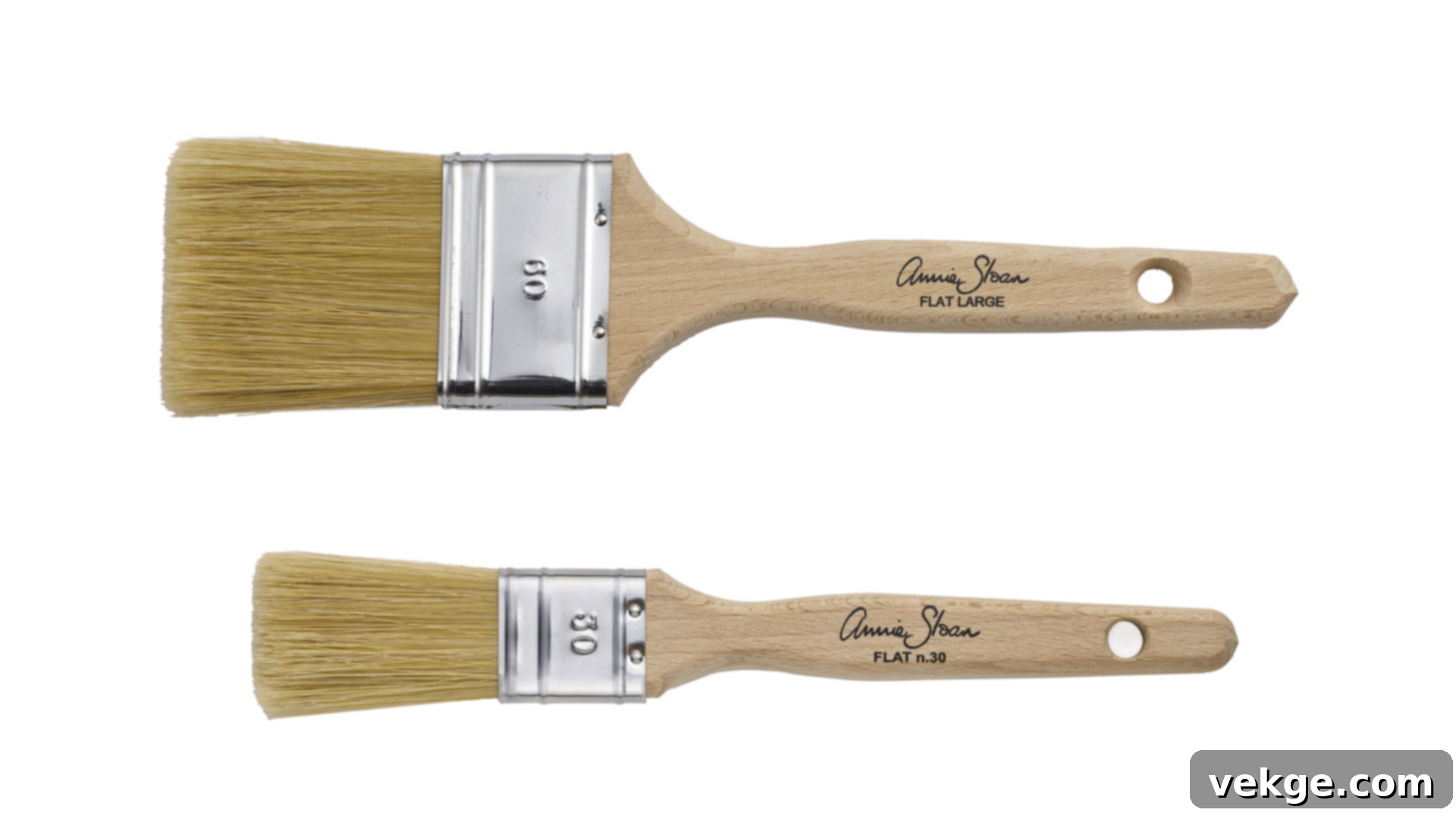
Annie Sloan’s flat brush is often considered the gold standard for chalk paint applications, especially given her pioneering role in the chalk paint movement. It features high-quality, firm natural bristles that are perfectly suited to handle the thick, creamy consistency of chalk paint. The flat shape of the brush allows for broad, sweeping strokes, providing incredibly smooth and even coverage over large surfaces. Its robust construction and various sizes make it an indispensable tool for painting furniture, cabinets, and other substantial pieces with efficiency and grace.
- Pros:
- Exceptional quality natural bristles designed for chalk paint.
- Provides superior paint retention and smooth, even coverage.
- Ideal for large, flat surfaces, ensuring quick and efficient painting.
- Durable construction built to last through numerous projects.
- Cons:
- Can be a significant investment compared to other brushes.
- Its flat, broader design may not be the most agile for intricate details or very small areas.
- Recommendation: An excellent choice for large furniture pieces, expansive cabinet doors, or even walls. Opt for this brush to achieve a truly smooth, professional, and consistent finish with minimal effort.
- Cost: Approximately $30-$40
2. Zibra Premium Paintbrush

Zibra brushes are celebrated for their innovative designs and high-quality synthetic bristles, which are meticulously crafted for optimal paint pickup and release. Their angled brushes are particularly outstanding for chalk paint, excelling at detailing edges, corners, and intricate trim work where precision is key. These brushes are engineered to provide a remarkably smooth, streak-free finish, making them a versatile addition to any chalk painter’s toolkit. The comfortable handles also reduce hand fatigue during extended painting sessions.
- Pros:
- High-quality synthetic bristles perform exceptionally well with chalk paint, offering a smooth application.
- Angled shape provides excellent control for cutting in, tight spots, and intricate details.
- Ergonomic handle ensures comfort and reduces strain during long painting projects.
- Known for delivering a streak-free finish.
- Cons:
- May require a slightly different application technique compared to natural bristles for optimal paint build-up.
- Some users might find the bristles a bit stiffer initially, requiring a short break-in period.
- Recommendation: Ideal for detailed work, sharp corners, clean edges, and any area requiring superior control and precision. A fantastic option for achieving crisp lines and a refined finish.
- Cost: Approximately $12.95
3. Purdy XL Brush
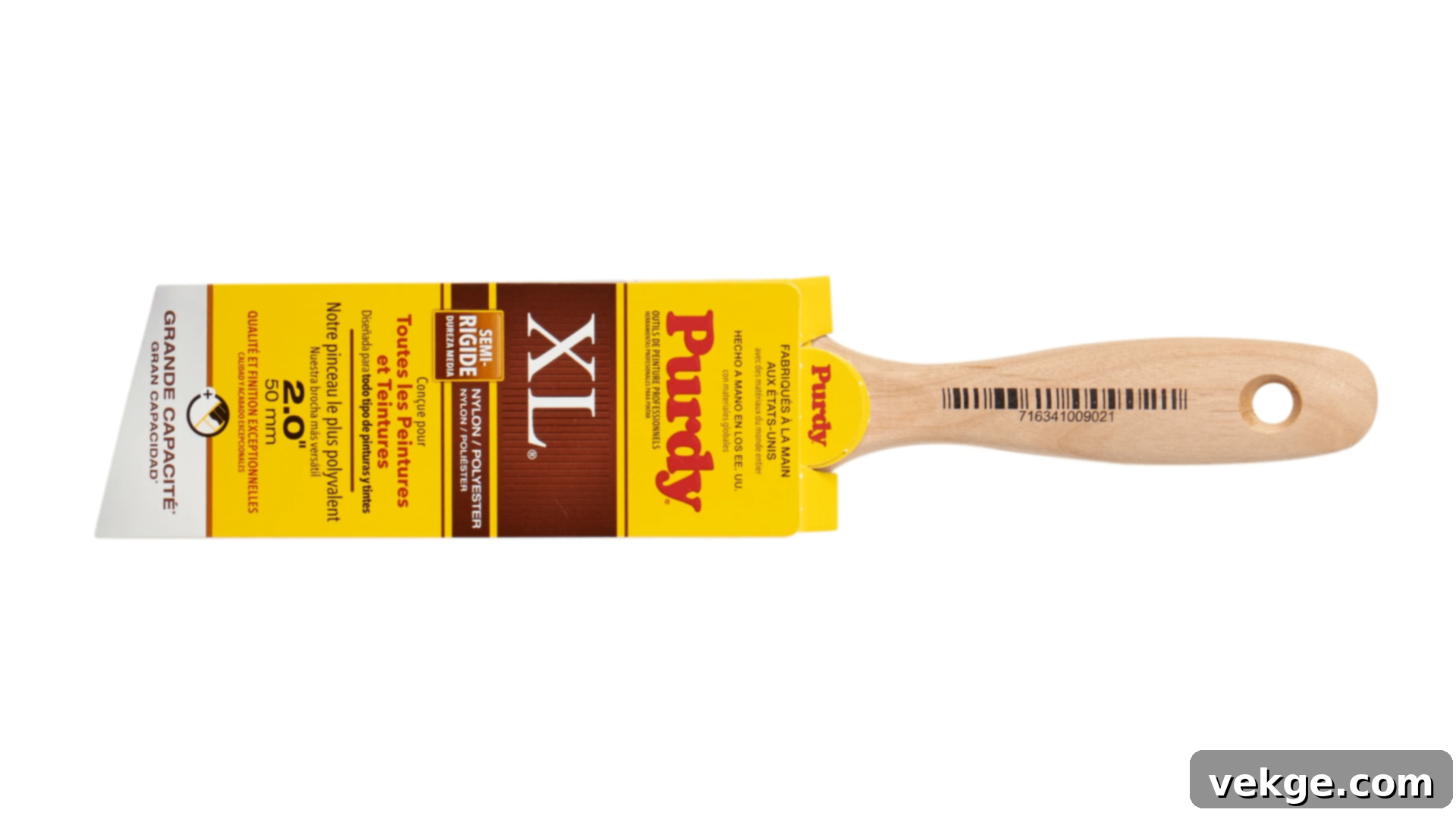
Purdy’s XL brush series is a highly respected line among professional painters, and its versatility extends beautifully to larger chalk paint projects. These brushes feature a blend of synthetic and natural bristles (depending on the specific model) that are designed to hold a substantial amount of paint and distribute it smoothly. The stiff, yet flexible, bristles make it remarkably easy to apply an even coat of chalk paint over expansive surfaces. Combined with Purdy’s signature ergonomic handles, these brushes provide comfort and control, making long painting sessions much more manageable and efficient.
- Pros:
- Excellent compatibility with chalk paint, ensuring smooth and consistent application.
- Firm bristles contribute to a flawless finish and help to minimize brush marks.
- Renowned for its durability and reliability, offering a long lifespan.
- Ergonomic handle provides comfort for extended use, reducing hand fatigue.
- Cons:
- Its larger size can be a bit cumbersome for very fine detail work or small, intricate areas.
- Can feel substantial and potentially heavy during exceptionally long projects, depending on the user.
- Recommendation: The go-to choice for tackling larger furniture pieces, wide cabinet panels, or any surface that requires quick and extensive coverage without sacrificing quality.
- Cost: Approximately $25-$30
4. Wooster Shortcut Brush
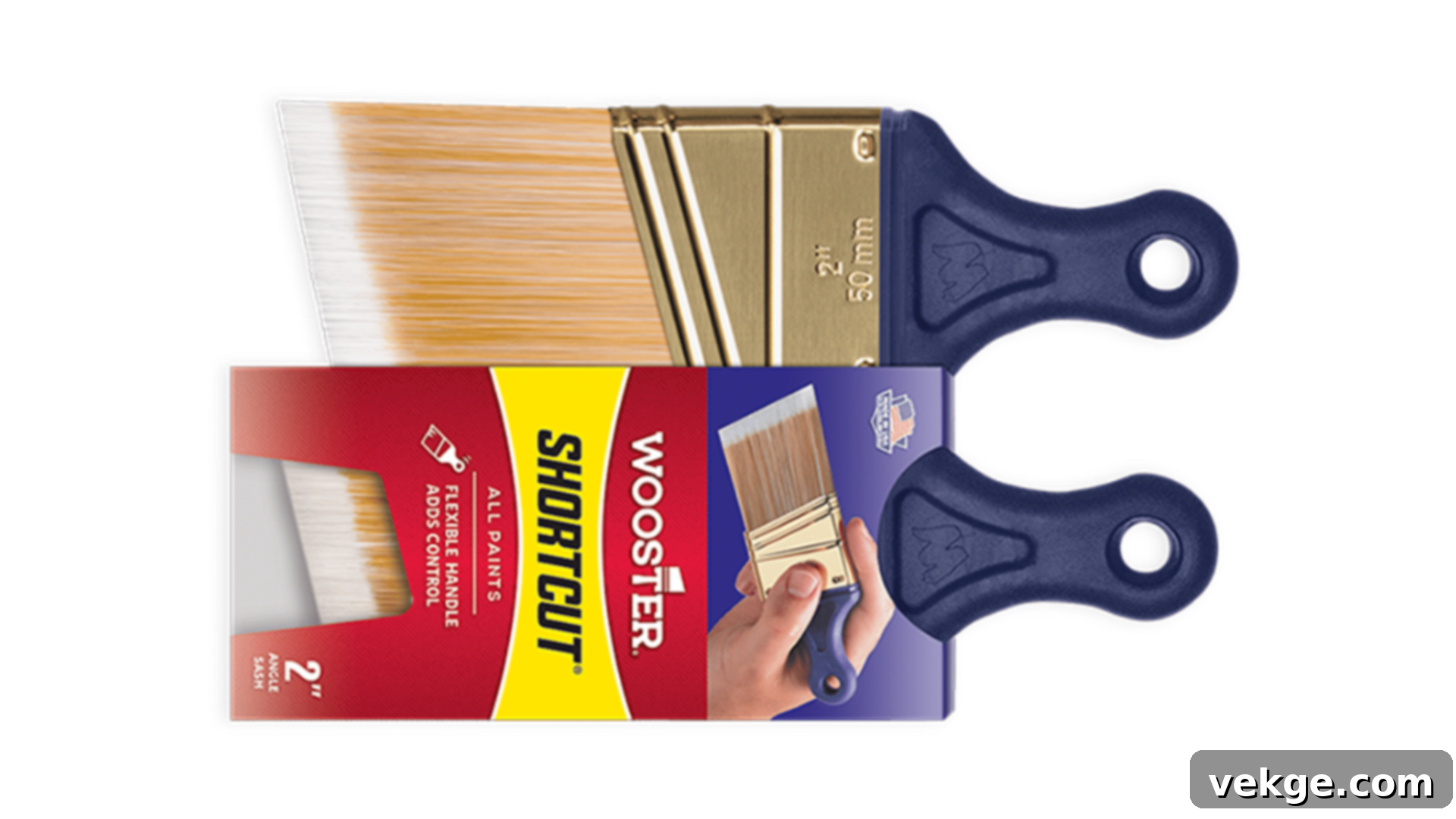
Wooster’s Shortcut brush is a fantastic, user-friendly option, particularly for smaller chalk paint projects or when working in tight, awkward spaces. Its distinctive short, thick, and flexible handle is designed to fit comfortably in your palm, offering enhanced control and maneuverability. This makes it an ideal tool for painting small furniture pieces, detailed sections, or intricate designs where precision is more important than broad coverage. The blend of synthetic bristles ensures smooth paint application and a clean finish.
- Pros:
- Short handle provides superior control and comfort, especially in confined spaces.
- Excellent for smaller areas, intricate designs, and delicate detailing.
- Comfortable, ergonomic grip reduces hand strain.
- Synthetic bristles offer smooth application and easy cleanup.
- Cons:
- Not practical for covering large surface areas efficiently due to its compact size.
- May require more frequent cleaning during a project due to its smaller paint-holding capacity.
- Recommendation: Best suited for transforming small furniture items, painting detailed trim work, or reaching tight spots on larger pieces where a standard brush might be too unwieldy.
- Cost: Approximately $10-$12
5. Pro Grade Paint Brush Set
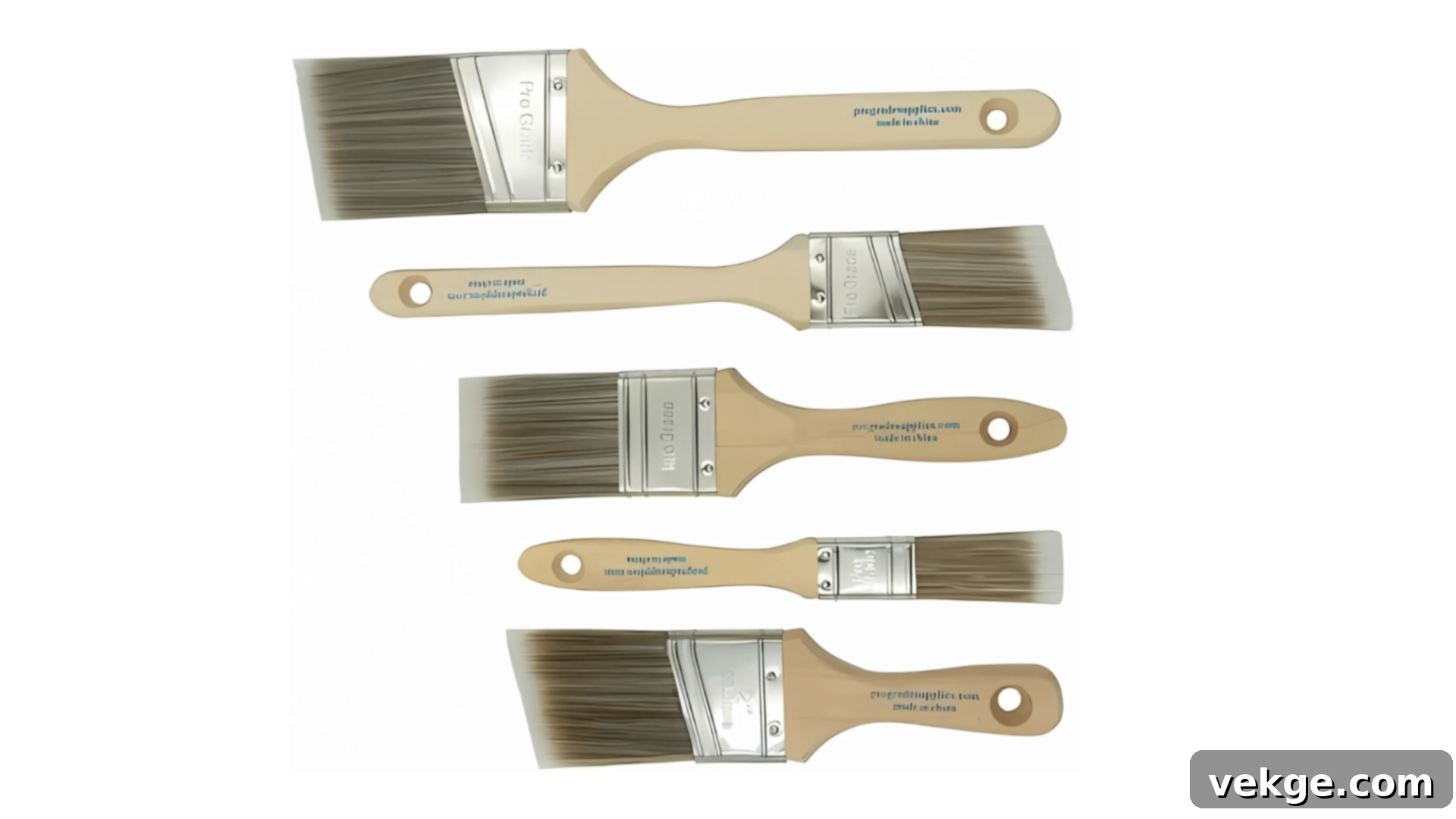
For those just starting their chalk painting journey or looking for a versatile collection of brushes without breaking the bank, a Pro Grade paintbrush set is an excellent choice. These sets typically offer a variety of brush sizes and shapes, providing flexibility for different project needs—from broad strokes to detailed work. While they might not possess the ultra-premium feel of high-end single brushes, they offer solid performance and great value, making them a practical starting point for any beginner or a handy backup set for experienced painters.
- Pros:
- Offers a versatile variety of brush sizes and shapes in a single, affordable set.
- Works effectively with chalk paint, as well as other paint types and finishes.
- An excellent and budget-friendly option for beginners to explore different brush types.
- Good value for money, providing tools for various tasks.
- Cons:
- Bristles may not hold as much paint as some higher-end, more specialized options.
- Some sets might experience initial bristle shedding, which usually subsides after a few uses and cleanings.
- Recommendation: A superb starter set for anyone new to chalk painting who desires a range of sizes and shapes for different aspects of their projects without a significant upfront investment.
- Cost: $7.95 (for a set)
6. The Chippy Brush

The Chippy Brush is specifically designed for those who embrace the rustic, distressed, or “shabby chic” aesthetic that chalk paint can so beautifully create. Known for its softer, more irregular bristles, this brush isn’t about achieving a perfectly smooth, flawless finish. Instead, it’s expertly crafted to help you create textured looks, subtle variations, and that charmingly aged appearance that many chalk paint projects aim for. It’s an invaluable tool for adding character and depth to vintage furniture and decorative items.
- Pros:
- Soft, unique bristles are ideal for creating a textured, distressed, or rustic finish.
- Excellent for achieving the popular shabby-chic look and adding character to pieces.
- Affordable and effective for specific decorative techniques.
- Cons:
- Not the best choice if your goal is a perfectly smooth, modern, or flawless finish.
- May require a bit more effort in cleaning due to its bristle structure, or it might be considered a disposable option for very specific projects.
- Recommendation: A must-have brush if you’re aiming for a charmingly textured, weathered, or rustic effect on your furniture or decorative accents. It’s perfect for capturing that authentic vintage feel.
- Cost: Approximately $3.99
7. Dixie Belle Mini Brush
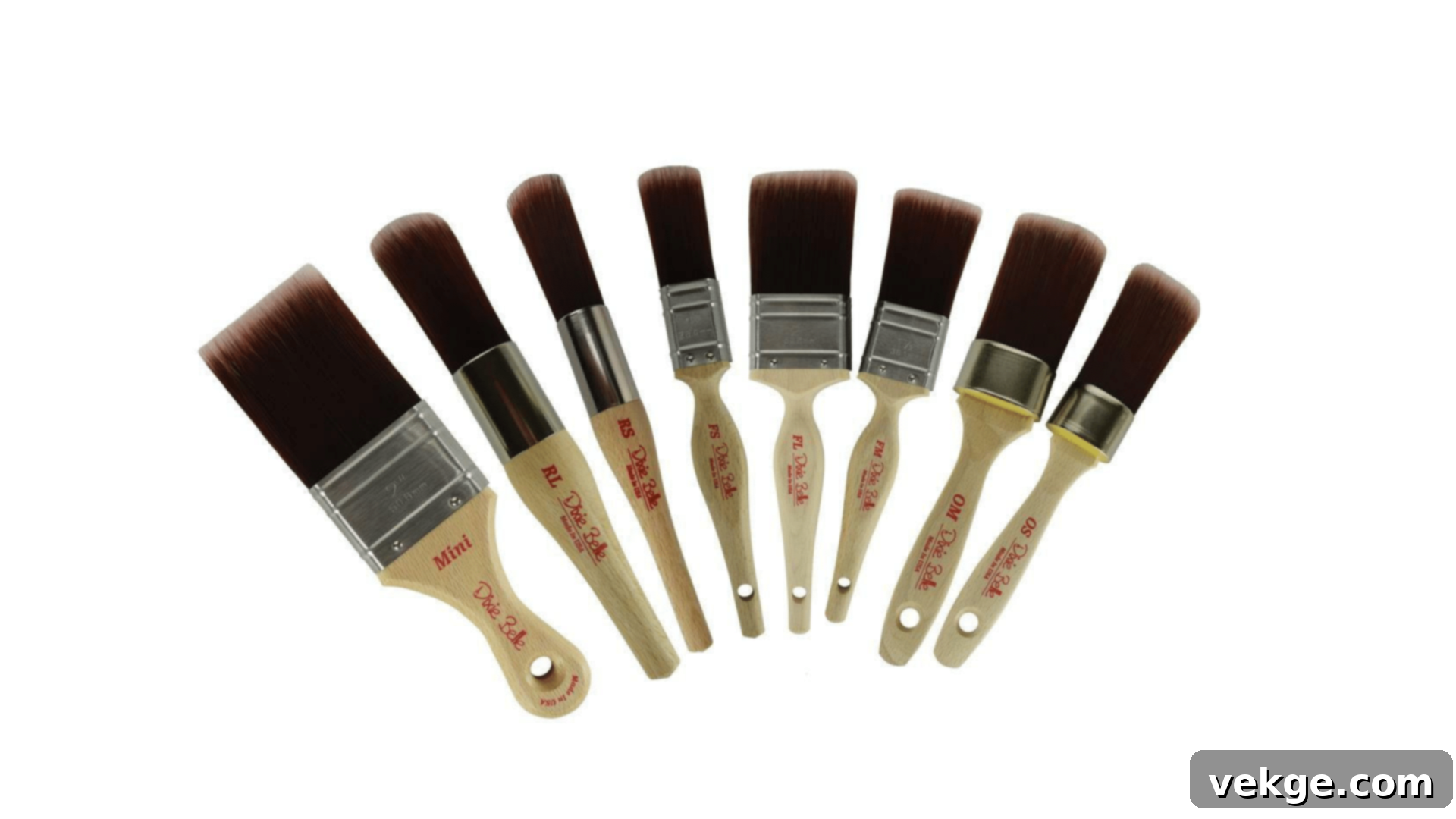
The Dixie Belle Mini Brush is a small, round brush meticulously designed for precision and intricate detail work, a crucial aspect of many chalk paint transformations. Its compact size and rounded shape make it exceptionally maneuverable for painting edges, trim, carvings, and smaller furniture pieces with finesse. Crafted with high-quality synthetic bristles, it delivers a smooth, streak-free finish even in tight spaces, ensuring every detail of your project is perfectly executed.
- Pros:
- Small, round shape is perfect for intricate detail work, edges, and delicate trim.
- Provides excellent control and precision in corners and hard-to-reach areas.
- High-quality synthetic bristles ensure a smooth, streak-free application.
- Comfortable to hold for detailed tasks.
- Cons:
- Due to its small size, it will take considerably longer to cover large surfaces, making it impractical for bigger projects.
- Not designed for broad coverage or painting expansive areas efficiently.
- Recommendation: An indispensable tool for small projects, fine detailing, painting drawer fronts, intricate carvings, or adding delicate accents to your chalk-painted pieces.
- Cost: Approximately $5-$10
8. Rust-Oleum Chalked Paint Brush
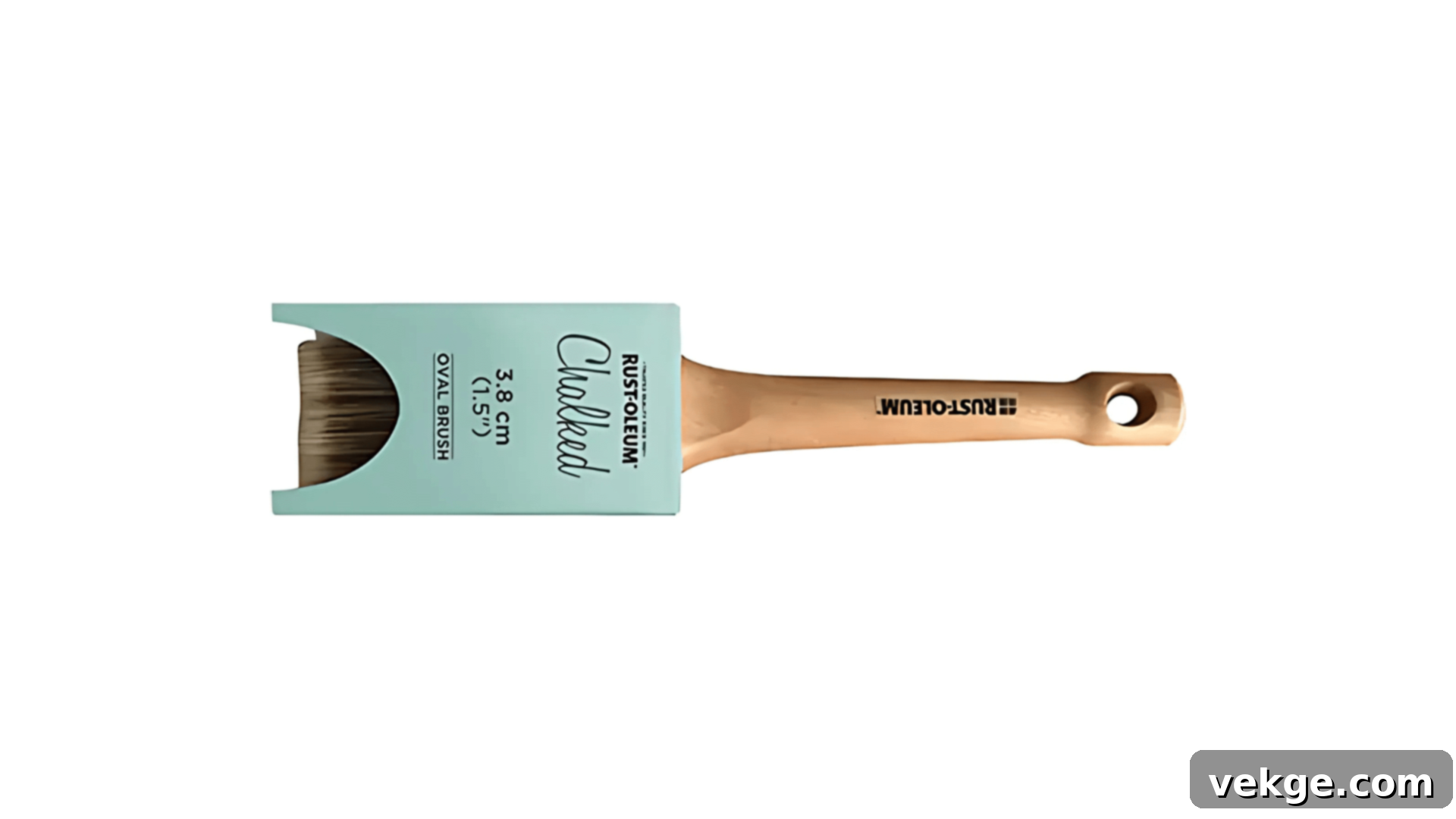
As a widely accessible and reputable paint brand, Rust-Oleum offers its own specialized Chalked Paint Brush. This brush is specifically engineered for use with Rust-Oleum’s popular “Chalked” paint line, but performs well with other chalk paints too. Featuring synthetic bristles, it’s designed to deliver a smooth application with minimal brush strokes. The brush boasts an ergonomic handle, providing comfort during extended use, and its balanced design makes it suitable for both larger surfaces and more intricate details, offering a good all-around performance for its price point.
- Pros:
- Soft yet flexible synthetic bristles promote smooth paint application.
- Ergonomic handle provides comfort, making it easy to use for longer periods.
- Generally an affordable option, offering good value for its performance.
- Widely available and easy to find.
- Cons:
- Bristles may show signs of wear quicker than those on more premium, high-end brands.
- May not be as firm as some natural bristle brushes, which could be a factor for extremely thick chalk paint formulations.
- Recommendation: An excellent entry-level choice for beginner DIYers or those working on a budget. It’s well-suited for smaller to medium-sized furniture pieces, crafts, and general chalk painting tasks where a reliable, affordable brush is needed.
- Cost: Approximately $10-$15
9. PaintPixie Mini Pixie Brush
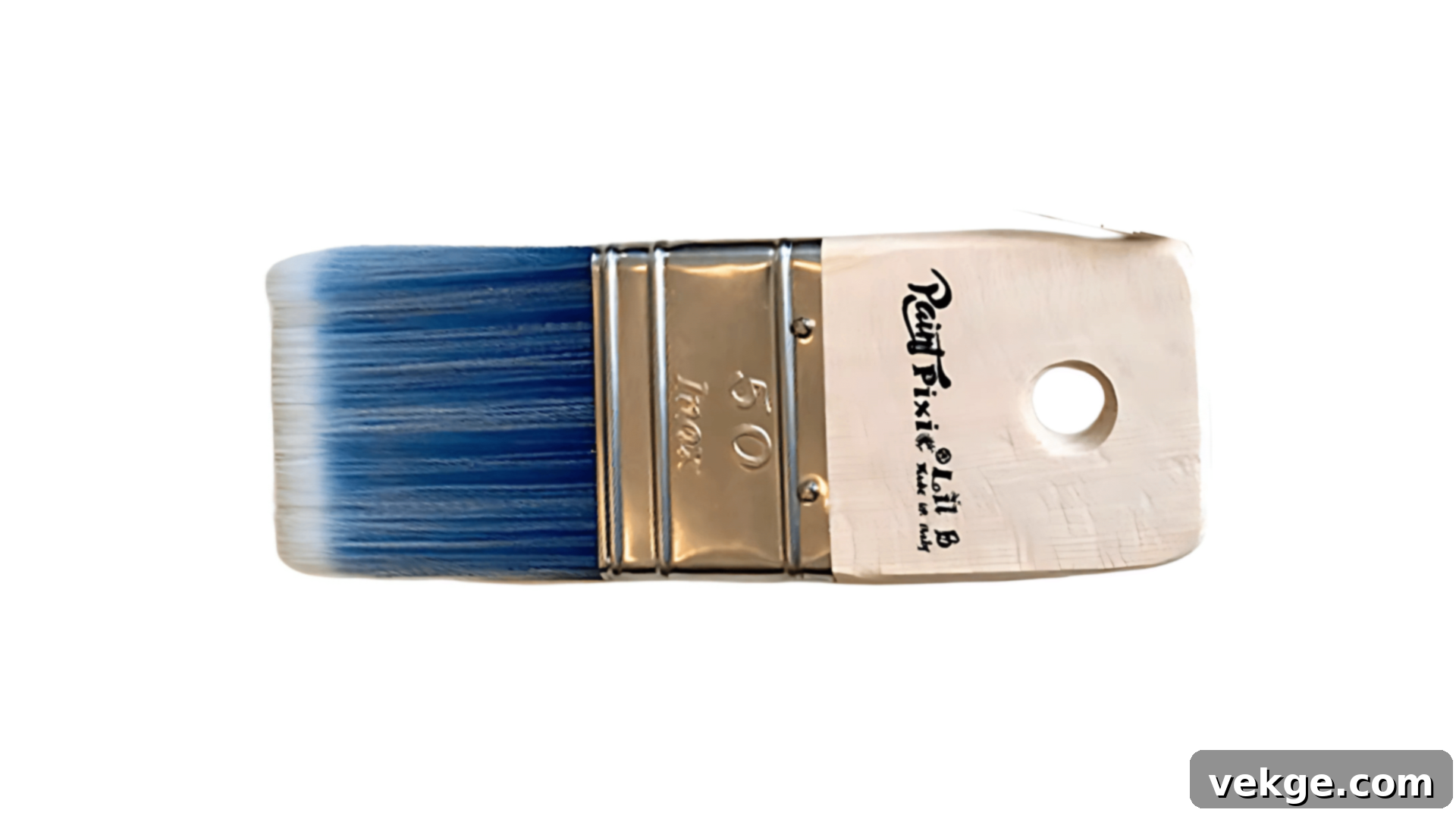
The PaintPixie Mini Pixie Brush, often found with natural bristles (though synthetic options may exist), is a delightful small brush specifically crafted for the most intricate and detailed aspects of chalk painting. Its fine, dense bristles are perfect for achieving very delicate designs, fine lines, and reaching into the smallest nooks and crannies. This brush is highly regarded for its ability to provide an exceptionally even finish without streaks, making it ideal for precision work where perfection is key.
- Pros:
- Exceptional for intricate designs, fine details, and delicate artistic touches.
- Often features high-quality natural bristles for excellent paint holding and release.
- Delivers a consistently even finish, minimizing frustrating streaks.
- Provides superior control for precision tasks.
- Cons:
- Its diminutive size makes it entirely unsuitable for anything other than very small areas or detailing.
- Using it for larger projects would be extremely time-consuming and inefficient.
- Recommendation: The ultimate brush for adding delicate details, intricate stenciling, or precise designs to furniture, decorative trim, or small art pieces. A specialist tool for finishing touches.
- Cost: Approximately $15-$25
10. Wooster Shortcut Angled Brush
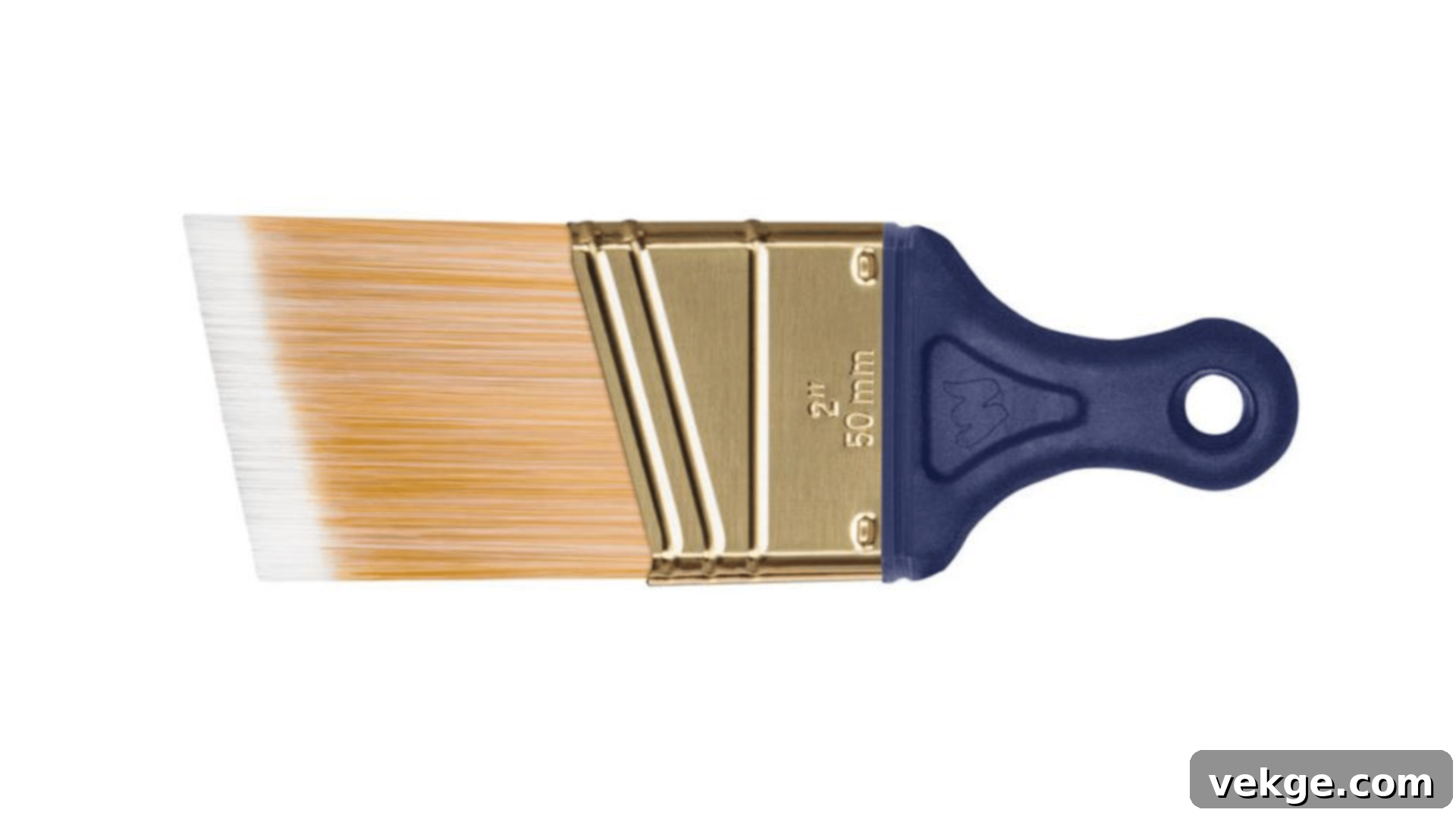
Expanding on the success of their original Shortcut brush, the Wooster Shortcut Angled Brush combines the ergonomic benefits of the short handle with an angled bristle design. This makes it an indispensable tool for achieving crisp lines, sharp edges, and clean corners when working with chalk paint. The high-quality synthetic bristles are designed for smooth application and durability, ensuring a professional finish. Its comfortable, flexible handle fits perfectly in the hand, providing unmatched control for precision cutting-in and detailing tasks.
- Pros:
- Angled bristles are perfectly shaped for creating sharp, clean edges and reaching into corners.
- Comfortable and ergonomic short handle offers superior control and reduces fatigue.
- High-quality synthetic bristles deliver a smooth, professional finish.
- Excellent for precision work and cutting-in.
- Cons:
- While versatile, it’s still relatively small, making it less efficient for expansive surfaces.
- The bristles might feel a bit stiff when applying very thick, undiluted chalk paint, requiring a lighter touch.
- Recommendation: Your ideal choice for any detailed work involving edges, trim, or achieving perfectly defined lines on your chalk paint projects. It’s a precision tool for a polished look.
- Cost: Approximately $12.95
Which One to Choose Over the Other? A Quick Selection Guide
To help you quickly decide, here’s a summary of recommendations based on your project needs:
- For Large Projects & Broad Coverage: If you’re tackling big furniture pieces, cabinets, or walls, prioritize brushes like the Annie Sloan Flat Brush or the Purdy XL Brush. These are specifically designed for efficiency and speed over expansive areas.
- For Detail Work & Precision: When intricate designs, sharp edges, or tight corners are your focus, opt for the Wooster Shortcut Brush, Zibra Premium Paintbrush (angled), Dixie Belle Mini Brush, or PaintPixie Mini Pixie Brush. They offer the control and accuracy needed for delicate tasks.
- For Textured & Distressed Finishes: If your goal is a charmingly rustic, aged, or distressed finish, The Chippy Brush is your best companion, designed to create those desired unique textures.
- Budget-Friendly & Beginner Options: For those new to chalk painting or working within a budget, the Pro Grade Paint Brush Set and Rust-Oleum Chalked Paint Brush offer excellent value, versatility, and a great starting point for various projects.
How to Choose the Best Brushes for Chalk Paint?
Navigating the array of brush options can feel daunting, but by focusing on a few key factors, you can confidently select the perfect brush for any chalk paint project. Here’s a breakdown of what to consider:
1. Brush Shape
The shape of your brush is a critical determinant of its application style and effectiveness for different tasks. Each shape is engineered for a specific purpose, directly influencing the finish you achieve with chalk paint. Understanding these shapes will dramatically improve your painting efficiency and results.
Flat Brushes
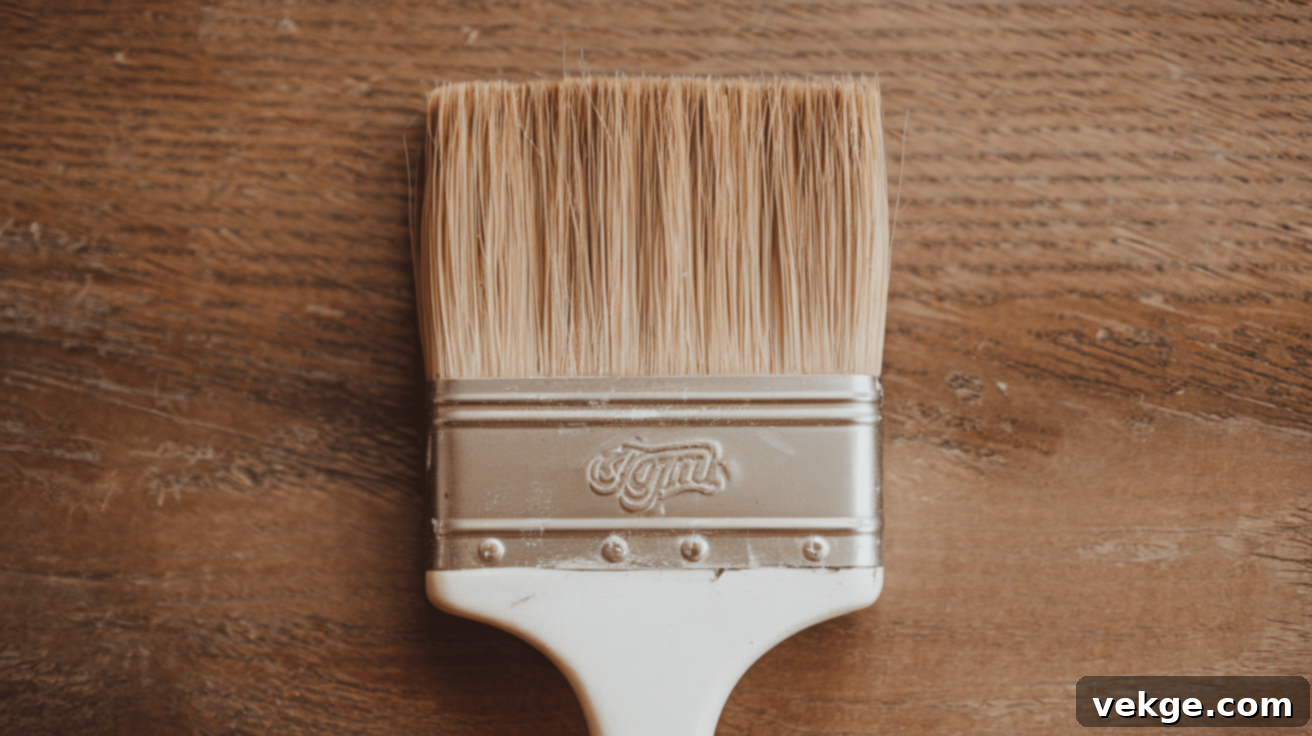
Flat brushes are arguably the most common and versatile brushes. Characterized by their wide, rectangular bristles, they are the go-to choice for covering large, flat surfaces quickly and efficiently. They excel at spreading paint evenly and providing smooth, consistent coverage with minimal texture. If your project involves painting significant areas like tabletops, cabinet doors, or large furniture panels, a flat brush will be your most effective tool, ensuring broad strokes and a uniform finish.
Round Brushes
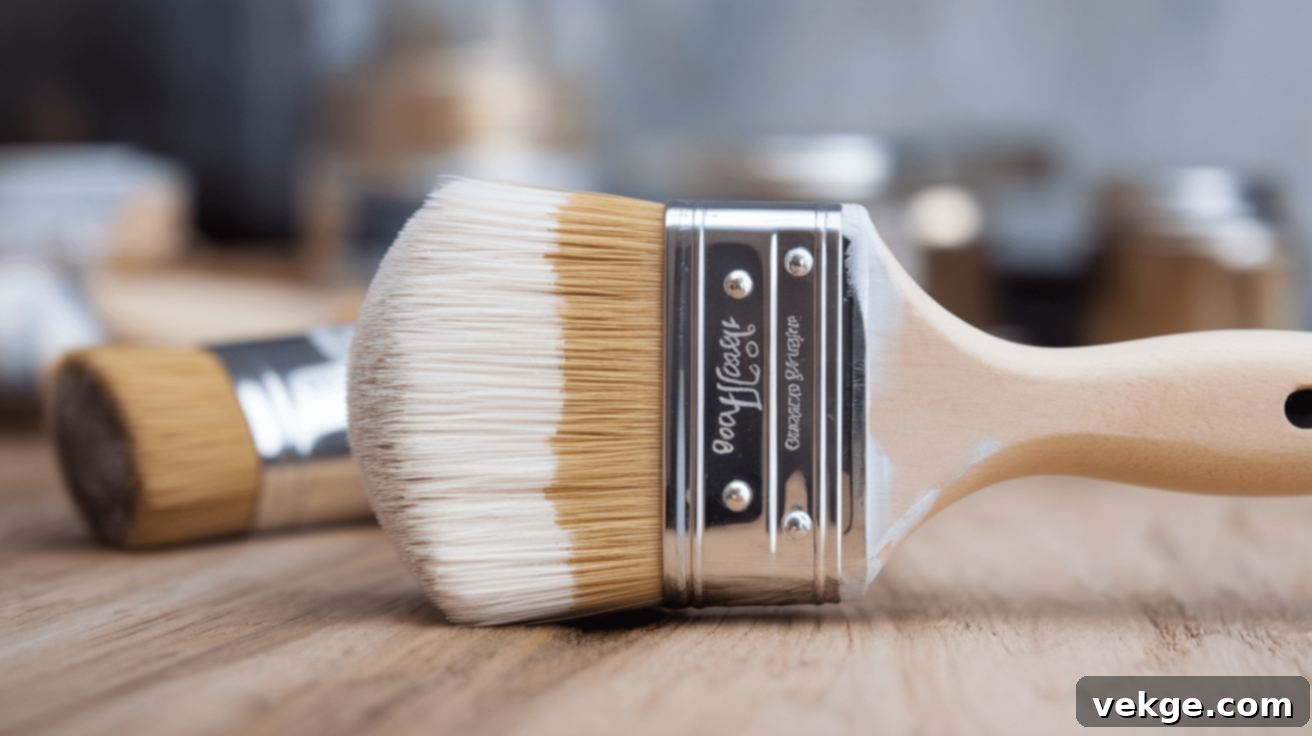
Round brushes, with their circular bristle configuration, are invaluable for detail work, reaching into corners, and navigating intricate edges. They offer exceptional control over paint placement, making them particularly useful for smaller surfaces, carved details, or areas that demand precision. Their ability to hold a good amount of paint and release it evenly in tight spots makes them perfect for intricate designs, stenciling, or applying finishing touches around hardware and trim.
Angled Brushes
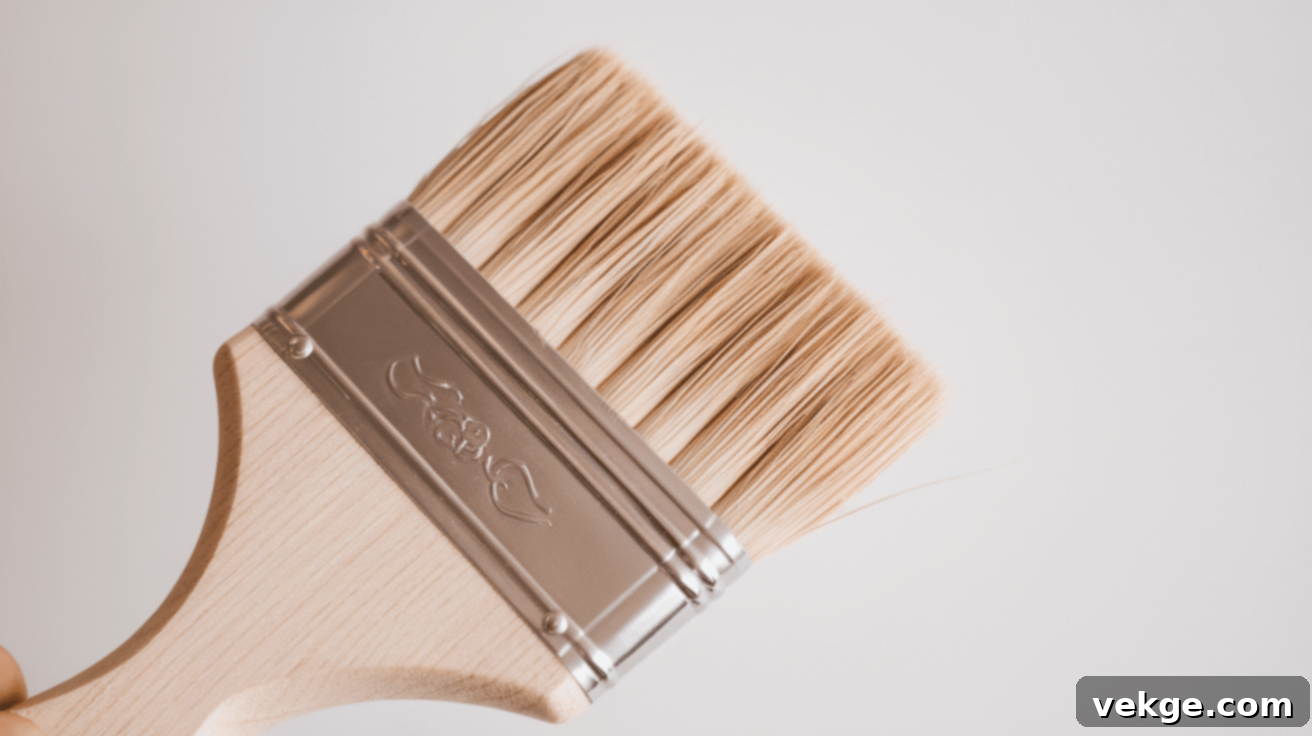
Angled brushes feature bristles cut at an angle, creating a sharp, precise edge. This design makes them ideal for cutting in, painting along lines, and achieving crisp, clean edges without smudges or drips. They are superb for painting trim, molding, or other linear elements where you need to separate painted and unpainted sections distinctly. The angled tip allows for fine control, ensuring professional-looking results even in challenging areas.
Fan Brushes
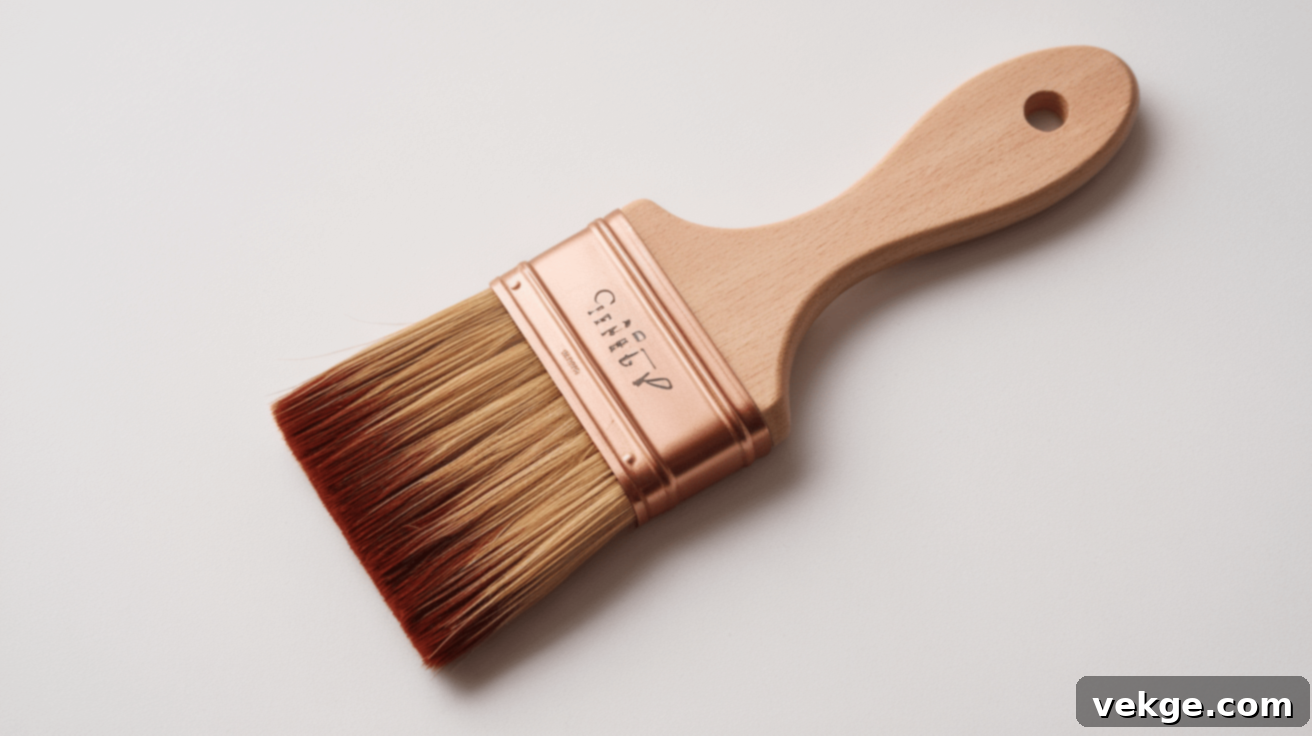
Fan brushes are less common for general chalk paint application but are indispensable for specialized artistic effects. With their splayed, fanned-out bristles, they are excellent for creating unique textures, blending colors, or achieving a softly distressed finish. If you’re aiming for a subtle, wispy effect, or want to blend multiple chalk paint colors seamlessly for an artistic look, a fan brush can be a very creative tool in your arsenal.
2. Brush Size
Just as important as shape, the size of your brush significantly impacts your efficiency and the quality of your finish. Matching the brush size to the scale of your project is key to both speed and precision:
- Large Brushes (2-3 inches wide or more): These are your workhorses for extensive surfaces. For cabinets, tabletops, dressers, or doors, a larger brush allows you to cover considerable areas quickly and with fewer strokes, leading to a more uniform appearance. Using a small brush on a large surface will result in unnecessary effort and potentially more visible brush marks due to too many overlapping strokes.
- Small Brushes (1 inch wide or less): When tackling intricate details, painting trim, edges of furniture, or working on smaller decorative items, a smaller brush is essential. It provides the precise control needed in tight spots, ensuring that paint is applied exactly where you want it without bleeding into unwanted areas. Trying to use a large brush for small details will inevitably lead to mistakes and frustration.
3. Bristle Material
The material of the brush bristles is perhaps the most crucial factor determining how a brush interacts with chalk paint. Chalk paint brushes typically feature either natural or synthetic bristles, each offering distinct advantages:
Natural Bristles
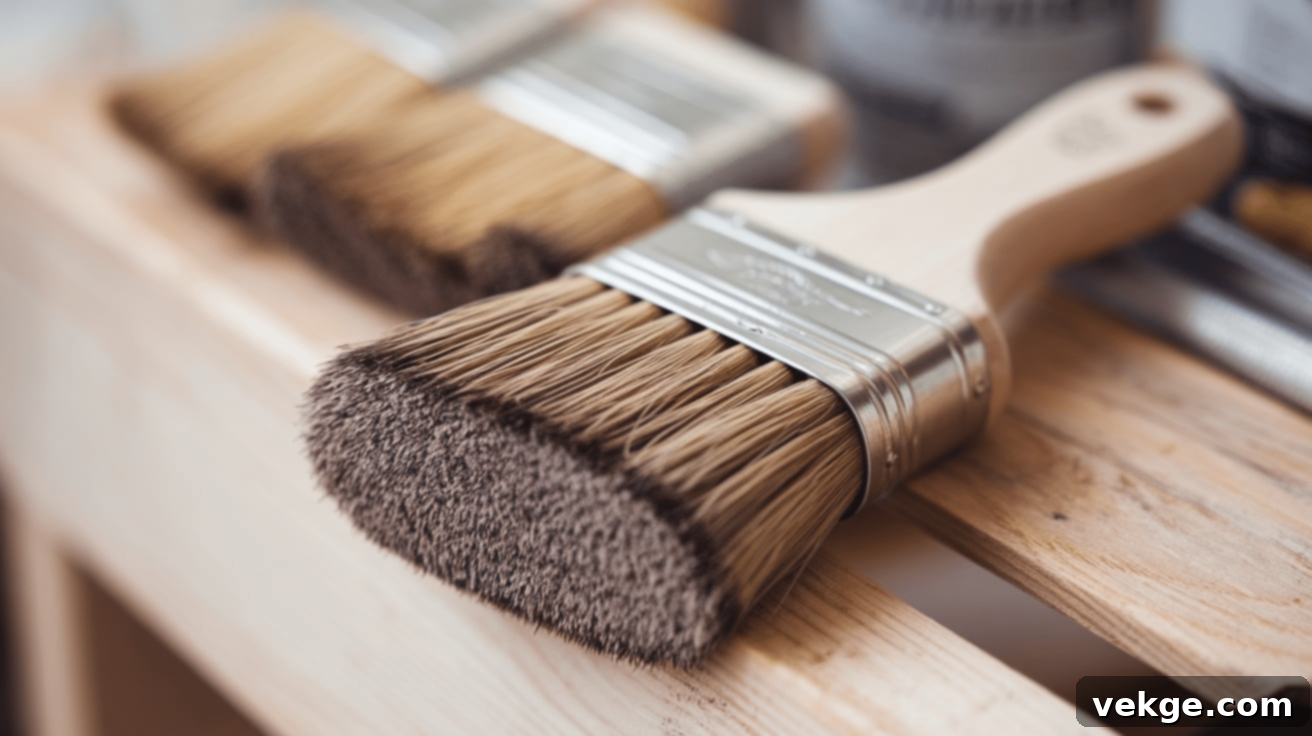
Natural bristle brushes are crafted from animal hair, commonly hog or ox hair. These bristles are thicker, stiffer, and often have a natural “flagged” (split) tip, which allows them to hold a significant amount of paint. They are exceptionally well-suited for chalk paint because they absorb the paint effectively and distribute it with a distinctive, almost tactile feel. Natural bristles are particularly favored for achieving a distressed or textured look, as they can create subtle brush marks that add character. They also tend to last a long time with proper care.
Synthetic Bristles
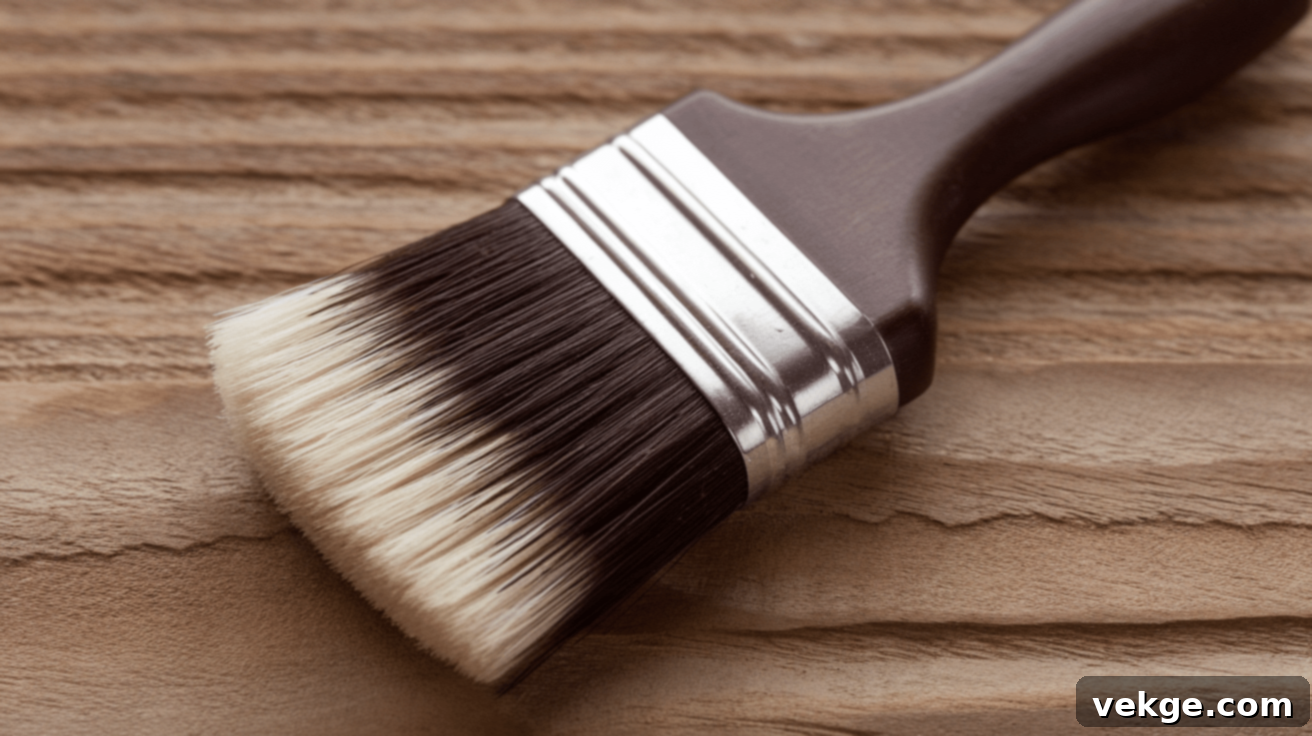
Synthetic bristles are made from man-made fibers such as nylon or polyester. These brushes are typically softer and more flexible than natural bristle brushes, and they often come with tapered tips designed to mimic the performance of natural hair. While they may not absorb as much paint as natural bristles, high-quality synthetic brushes perform admirably with chalk paint, especially when aiming for a super smooth, streak-free finish. They are also easier to clean, less prone to shedding, and often more durable, making them a popular choice for many chalk painters.
4. Handle Type
The handle of your brush might seem like a minor detail, but it plays a significant role in comfort, control, and reducing fatigue during long painting sessions. Brushes come with either wooden or plastic handles, each with its own set of benefits:
- Wooden Handles: Often found on higher-quality brushes, wooden handles are typically more durable and offer a substantial, comfortable grip. Their added weight can provide a sense of balance and precision, which is particularly beneficial for larger projects requiring consistent strokes or for detailed work where control is paramount. Many prefer the classic feel and robustness of a wooden handle.
- Plastic Handles: Plastic handles are generally lighter and can be easier to maneuver for some users, especially on smaller projects. They are also often found on more affordable brushes. While they may sometimes lack the ergonomic comfort and durability of well-made wooden handles, modern designs are increasingly comfortable and functional, offering a good balance of weight and grip.
Brush Strokes: How to Avoid Them for a Seamless Finish
One of the most common challenges and desired outcomes with chalk paint is achieving a smooth, seamless finish without visible brush strokes. While some embrace a subtle texture, many prefer a perfectly even surface. Here are essential tips to minimize brush strokes and get that flawless look:
1. Use the Right Brush
As emphasized throughout this guide, the brush itself is your first line of defense against unwanted strokes. A brush specifically designed for chalk paint, featuring firm, densely packed natural or high-quality synthetic bristles, is crucial. These brushes are engineered to distribute the paint evenly, allowing you to control the flow and lay down smooth layers. Using an inappropriate brush with too soft or sparse bristles will almost guarantee streaky results.
2. Work in Thin Layers
Resist the temptation to apply thick coats of chalk paint. Thick layers are much more prone to showing brush marks, especially as the paint begins to dry. Instead, apply thin, even layers. Allow each coat to dry completely before applying the next. This build-up approach ensures better adhesion, a more consistent finish, and significantly reduces the visibility of brush strokes. Patience is key here.
3. Lightly Sand Between Coats
After each coat of chalk paint has thoroughly dried, take a moment to lightly sand the entire surface using very fine-grit sandpaper (220-320 grit is often suitable). This crucial step helps to smooth out any minor brush strokes, imperfections, or rough textures that may have appeared. After sanding, always wipe away any dust with a damp cloth or tack rag before applying the subsequent coat to ensure a clean surface for adhesion.
4. Use a Light Touch and Long, Even Strokes
Avoid pressing down too hard on the brush. A light, gentle touch is all that’s needed to distribute chalk paint effectively. Use long, fluid, and even strokes, allowing the brush to glide effortlessly across the surface. Overworking the paint by going back and forth too many times or applying excessive pressure can push the paint around unevenly and create noticeable streaks and texture. Let the brush and paint do the work.
5. Brush in the Same Direction
Consistency is vital. Always brush in the same direction—either vertically or horizontally, depending on the orientation of the surface you are painting. This creates a uniform pattern that minimizes the appearance of overlapping strokes. Avoid haphazardly brushing in multiple directions, as this will inevitably leave behind visible lines and an inconsistent finish.
6. Slightly Dilute Your Chalk Paint (If Needed)
If your chalk paint feels exceptionally thick or you’re consistently struggling with brush strokes, consider adding a very small amount of water (about 5-10%) to thin it slightly. Mix thoroughly. This can improve the paint’s flow and make it easier to achieve a smoother finish. Be cautious not to over-dilute, as this can reduce the paint’s opacity and coverage.
Can You Use a Regular Paintbrush for Chalk Paint?
While you certainly *can* technically use a regular paintbrush for chalk paint, it’s generally not recommended if you’re aiming for optimal results. As discussed, chalk paint has a distinct, often thicker consistency compared to standard latex or oil-based paints, and regular brushes are simply not designed to handle it effectively. The primary issues you might encounter include:
- Subpar Finish: Regular brushes often lead to visible brush strokes, uneven application, and a patchy finish because their bristles may be too soft, too stiff, or improperly shaped for chalk paint.
- Reduced Control: The lack of specific design features means less control over paint flow and placement, making it harder to achieve clean lines and consistent coverage.
- Frustration and Extra Work: You might find yourself needing more coats to achieve opacity, and spending extra time sanding to correct imperfections, ultimately prolonging your project and increasing effort.
- Premature Brush Wear: Softer bristles in regular brushes can get damaged or frayed more quickly when working with thicker chalk paint.
If you absolutely must use a regular brush, choose one with relatively firm, high-quality synthetic or natural bristles, and opt for a medium-to-large size. A brush that’s too small will require excessive effort and too many coats to cover a surface, while a brush that’s too large could be difficult to control for anything other than very broad strokes. However, for the best experience and most professional outcome, investing in a brush specifically made for chalk paint is a decision you won’t regret.
Conclusion
In conclusion, mastering chalk paint projects hinges significantly on selecting the right brush. While the allure of transforming old pieces with chalk paint is strong, the proper tools are your greatest allies in achieving a smooth, professional, and lasting finish. We’ve explored why specialized brushes are essential for handling chalk paint’s unique consistency and delved into various top-performing options, from versatile flat brushes to precision-focused angled and mini brushes.
Remember to consider key factors like brush shape for specific tasks, appropriate size for efficiency, bristle material for desired texture and durability, and handle type for comfort. Armed with this knowledge, you can confidently choose between natural bristles for a textured, classic look or synthetic bristles for a super smooth, modern finish.
Beyond selection, applying the right techniques is crucial. Always work in thin layers, allow sufficient drying time, lightly sand between coats to eliminate imperfections, and use a consistent, light touch with strokes in the same direction. By combining the best tools with these tried-and-true methods, your chalk painting projects will not only look beautiful and professional but also stand the test of time. Happy painting!
Frequently Asked Questions About Chalk Paint Brushes
What is the best brush for chalk paint?
The “best” brush depends on your project. For large, smooth areas, a firm, flat brush (like Annie Sloan’s) is excellent. For details and edges, an angled or round synthetic brush (like Zibra or Dixie Belle Mini) works wonderfully. High-quality natural or synthetic bristles specifically designed for chalk paint are always preferred for optimal results.
Can I use a regular paintbrush for chalk paint?
While you can technically use a regular paintbrush, it’s not ideal. Regular brushes may leave streaks, provide uneven coverage, and make it harder to achieve the smooth finish chalk paint is known for. Brushes specifically designed for chalk paint offer better control and superior results.
Why are special brushes needed for chalk paint?
Chalk paint has a thick, creamy consistency that requires bristles designed to hold and distribute it evenly without streaking. Special brushes have the right density and firmness to work with this unique texture, ensuring smooth application and the desired matte or distressed finish.
What size brush should I use for chalk paint?
Use a larger brush (2-3 inches) for big surfaces like furniture tops or cabinet doors to cover areas quickly. For intricate work, trim, edges, or small decorative items, opt for a smaller brush (1 inch or less) to ensure precision and control.
How do I clean chalk paint brushes?
Immediately after use, rinse your brushes thoroughly with warm water and a mild soap until all paint is removed. Squeeze out excess water, reshape the bristles, and hang or lay flat to dry. Proper cleaning helps maintain bristle integrity and prolongs brush life.
Should I use natural or synthetic bristles for chalk paint?
Natural bristles (e.g., hog hair) are excellent for holding more paint and creating a slightly textured, often distressed finish. Synthetic bristles (e.g., nylon, polyester) are great for achieving a smoother, streak-free finish and are easier to clean. Many high-quality synthetic brushes are now specifically formulated to mimic the performance of natural bristles with chalk paint.
